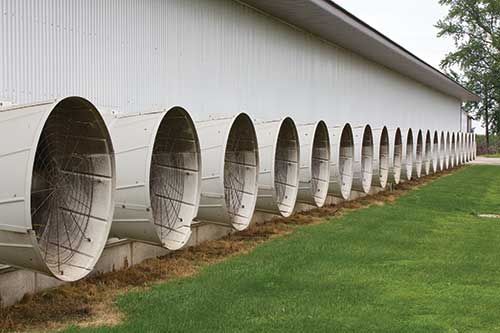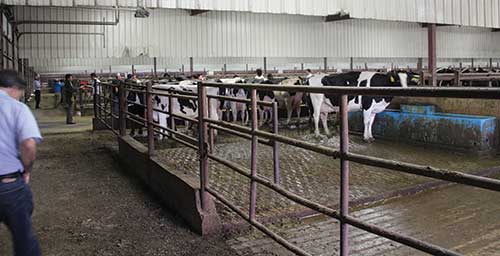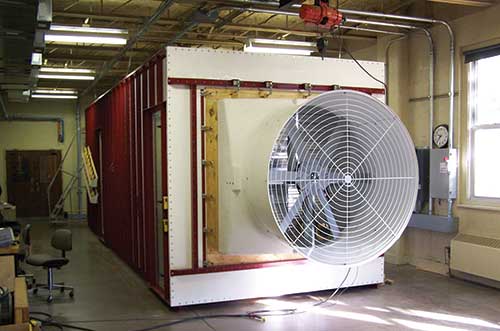The author is a research engineer and the BESS (Bio-Environmental and Structural System) lab manager at the University of Illinois.

On today's dairy farms, there are a lot of different places where fans can be used. If you are looking to upgrade your barn's air quality, you must work with someone who really understands the ventilation business to get the right products for the job. In turn, those people need good measurable data, not just anecdotal evidence.
In the summer, we need fans to help keep barn temperatures down and to keep air moving over the cows. Fans can be coupled with evaporative cooling in the form of sprinklers or misters in the summer to further reduce body temperatures. Over the winter, we still need ventilation to maintain air quality and control humidity.

Ceiling baffles keep air velocities high at the cow level but also elevate the static pressure a fan must deal with.
Fans can be divided into two distinct classifications - circulating and exhaust ventilation. Circulating fans move air within a space. Ventilating fans exchange air. It's our job to select the right fan to get the job done.
Exhaust ventilation systems create negative pressure in a building, drawing fresh air through sidewalls or inlets and exhausting the stale building air through the fans. Even in cold weather, a minimum ventilation level must be maintained to control humidity and ammonia. Some of the newer barn designs with tunnel or cross flow ventilation systems may have 40 or more large exhaust fans that will operate during the hottest periods. Because of the volume of air moved during the summer months, efficiency is critical when choosing large summer fans.
Design guidelines such as those available through The Midwest Plan Service (www.mwps.org) and extension engineers can provide recommended ventilation rates (cubic feet per minute or cfm) for cold, mild, and warm weather. With this desired airflow defined, you can now compare fans for your application. Make sure all fan performance figures include the fan tested with shutter/damper, guards, and all standard attachments.
The Bio-Environmental and Structural Systems Lab (BESS) in the Department of Agricultural and Biological Engineering at the University of Illinois measures airflow performance (cfm) and Ventilation Efficiency Ratio (VER) (cfm/Watt or cfm/W) of commercially available ventilation fans and maintains a searchable database at www.bess.illinois.edu. Like miles per gallon in automobiles, a higher cfm/W denotes more output per unit of energy input.
Although some equipment manufacturers may publish performance figures based on 0-inch static pressure, ventilation fans rarely operate at this low pressure. Fan performance at 0.10-inch static pressure is a more realistic operating pressure for most applications, so be sure to compare efficiency ratings at this point. In some situations, even higher static pressures may be encountered affecting fan performance. Evaporative cooling pads, restrictive air inlet area, ceiling baffles, and wind blowing into a fan can all affect the static pressure a fan encounters.
Circulating fans stir the air. They supplement air movement over cows in naturally ventilated freestall barns. They may also be coupled with misting systems that wet cows' backs to improve the cooling effect.
Recently, the Air Movement and Control Association (AMCA) developed a new standard, AMCA 230-15, for rating circulating fans including airflow (cfm) and circulator efficacy (cfm/W). To find the size, number, type, and where to locate circulating fans, seek the advice of extension engineers and building designers experienced in specifying dairy circulating fans.
With the size and basic style of fan chosen, seek the most energy efficient fan model. Limit the comparison to fans of the same size, similar airflow levels, and adequate safety guards for the intended application. Among this group, look for the fan with the highest cfm/W.
Make sure the data provided is from either the 2012 or 2015 revision of the AMCA 230 test standard. The older 1999 test method provides artificially high airflow and energy efficiency numbers. In addition to cfm/W, some utility-based rebate programs still base circulator fan rebates on thrust efficacy (lbf/kW). Fans tested at the BESS Lab will include both of these efficacy ratings.

At the Bio-Environmental and Structural Systems Lab (BESS), airflow and VER (cfm/W) are measured over a range of static pressures.
The best fan for your needs depends on size, airflow capacity, number, fan style, and fan location. Efficiency is an important factor, too. Consider the following example of two commercially available 51-inch fans operating in a barn maintaining 0.10-inch static pressure.
Fan 1 - 24,100 cfm with a VER of 15.6 cfm/W
Fan 2 - 24,600 cfm with a VER of 23.6 cfm/W
Assuming 120 days operating 12 hours per day with electricity at 10 cents per kWh, the annual electricity cost for Fan 1 would be $222 as compared to only $150 for Fan 2. That is a savings of $72 annually for each fan installed.
Although they may cost more to purchase, many power companies provide rebate incentives for ventilation fans that meet their high cfm/W standards. They also can help you calculate the electricity savings when comparing new fans or the payback time in electricity savings when replacing older fans. These calculations help the producer decide which efficiency upgrades make the most economic sense.
After choosing efficient fans, make sure to maintain peak performance and efficiency by conducting the following maintenance:
You are moving a lot of air in some of these buildings, and having the right fan can mean all the difference. Fortunately, companies are designing better fans all the time. This means that they are moving more air at the same efficiency. Do your homework so you can find the fan that best meets your needs.
Click here to return to the Animal Care E-Sources
160525_354

On today's dairy farms, there are a lot of different places where fans can be used. If you are looking to upgrade your barn's air quality, you must work with someone who really understands the ventilation business to get the right products for the job. In turn, those people need good measurable data, not just anecdotal evidence.
In the summer, we need fans to help keep barn temperatures down and to keep air moving over the cows. Fans can be coupled with evaporative cooling in the form of sprinklers or misters in the summer to further reduce body temperatures. Over the winter, we still need ventilation to maintain air quality and control humidity.

Put air in motion
Fans can be divided into two distinct classifications - circulating and exhaust ventilation. Circulating fans move air within a space. Ventilating fans exchange air. It's our job to select the right fan to get the job done.
Exhaust ventilation systems create negative pressure in a building, drawing fresh air through sidewalls or inlets and exhausting the stale building air through the fans. Even in cold weather, a minimum ventilation level must be maintained to control humidity and ammonia. Some of the newer barn designs with tunnel or cross flow ventilation systems may have 40 or more large exhaust fans that will operate during the hottest periods. Because of the volume of air moved during the summer months, efficiency is critical when choosing large summer fans.
Design guidelines such as those available through The Midwest Plan Service (www.mwps.org) and extension engineers can provide recommended ventilation rates (cubic feet per minute or cfm) for cold, mild, and warm weather. With this desired airflow defined, you can now compare fans for your application. Make sure all fan performance figures include the fan tested with shutter/damper, guards, and all standard attachments.
The Bio-Environmental and Structural Systems Lab (BESS) in the Department of Agricultural and Biological Engineering at the University of Illinois measures airflow performance (cfm) and Ventilation Efficiency Ratio (VER) (cfm/Watt or cfm/W) of commercially available ventilation fans and maintains a searchable database at www.bess.illinois.edu. Like miles per gallon in automobiles, a higher cfm/W denotes more output per unit of energy input.
Although some equipment manufacturers may publish performance figures based on 0-inch static pressure, ventilation fans rarely operate at this low pressure. Fan performance at 0.10-inch static pressure is a more realistic operating pressure for most applications, so be sure to compare efficiency ratings at this point. In some situations, even higher static pressures may be encountered affecting fan performance. Evaporative cooling pads, restrictive air inlet area, ceiling baffles, and wind blowing into a fan can all affect the static pressure a fan encounters.
Keep mixing it up
Circulating fans stir the air. They supplement air movement over cows in naturally ventilated freestall barns. They may also be coupled with misting systems that wet cows' backs to improve the cooling effect.
Recently, the Air Movement and Control Association (AMCA) developed a new standard, AMCA 230-15, for rating circulating fans including airflow (cfm) and circulator efficacy (cfm/W). To find the size, number, type, and where to locate circulating fans, seek the advice of extension engineers and building designers experienced in specifying dairy circulating fans.
With the size and basic style of fan chosen, seek the most energy efficient fan model. Limit the comparison to fans of the same size, similar airflow levels, and adequate safety guards for the intended application. Among this group, look for the fan with the highest cfm/W.
Make sure the data provided is from either the 2012 or 2015 revision of the AMCA 230 test standard. The older 1999 test method provides artificially high airflow and energy efficiency numbers. In addition to cfm/W, some utility-based rebate programs still base circulator fan rebates on thrust efficacy (lbf/kW). Fans tested at the BESS Lab will include both of these efficacy ratings.

Calculate the savings
The best fan for your needs depends on size, airflow capacity, number, fan style, and fan location. Efficiency is an important factor, too. Consider the following example of two commercially available 51-inch fans operating in a barn maintaining 0.10-inch static pressure.
Fan 1 - 24,100 cfm with a VER of 15.6 cfm/W
Fan 2 - 24,600 cfm with a VER of 23.6 cfm/W
Assuming 120 days operating 12 hours per day with electricity at 10 cents per kWh, the annual electricity cost for Fan 1 would be $222 as compared to only $150 for Fan 2. That is a savings of $72 annually for each fan installed.
Although they may cost more to purchase, many power companies provide rebate incentives for ventilation fans that meet their high cfm/W standards. They also can help you calculate the electricity savings when comparing new fans or the payback time in electricity savings when replacing older fans. These calculations help the producer decide which efficiency upgrades make the most economic sense.
Maintain peak efficiency
After choosing efficient fans, make sure to maintain peak performance and efficiency by conducting the following maintenance:
- Clean shutters and guards. Studies have found dirty shutters can reduce airflow and efficiency 10 to 40 percent compared to a clean shutter.
- Lubricate shutter pivot points with silicone or Teflon-based lubricant. Do not use oils, which collect dust.
- Check belts for correct tension and replace when showing signs of excessive wear.
- Check pulleys for excessive wear.
You are moving a lot of air in some of these buildings, and having the right fan can mean all the difference. Fortunately, companies are designing better fans all the time. This means that they are moving more air at the same efficiency. Do your homework so you can find the fan that best meets your needs.
160525_354








